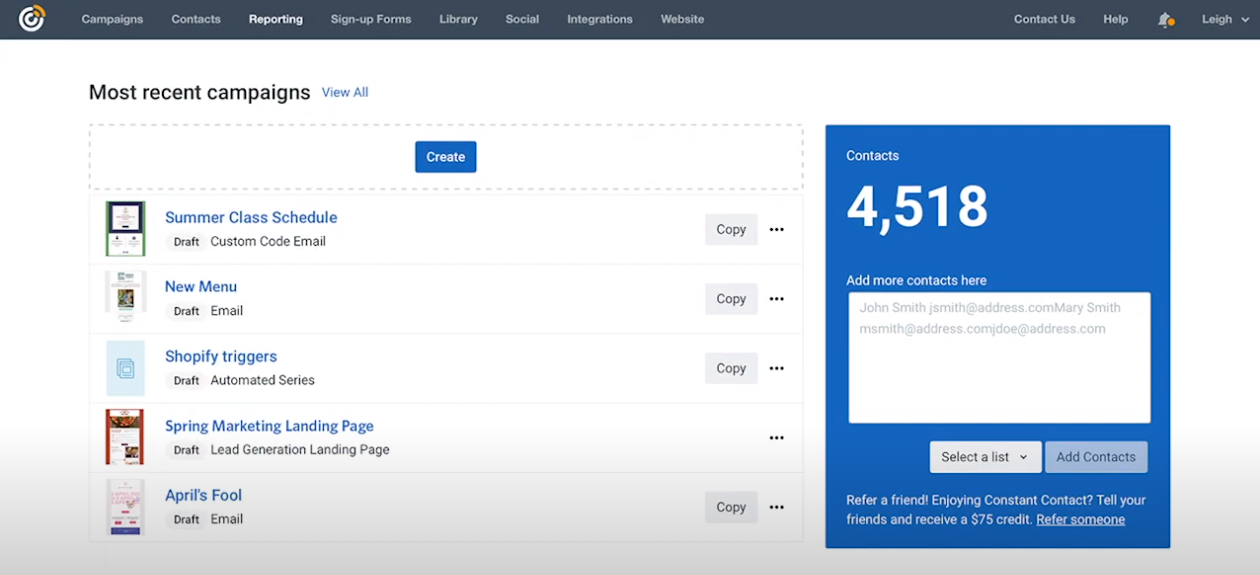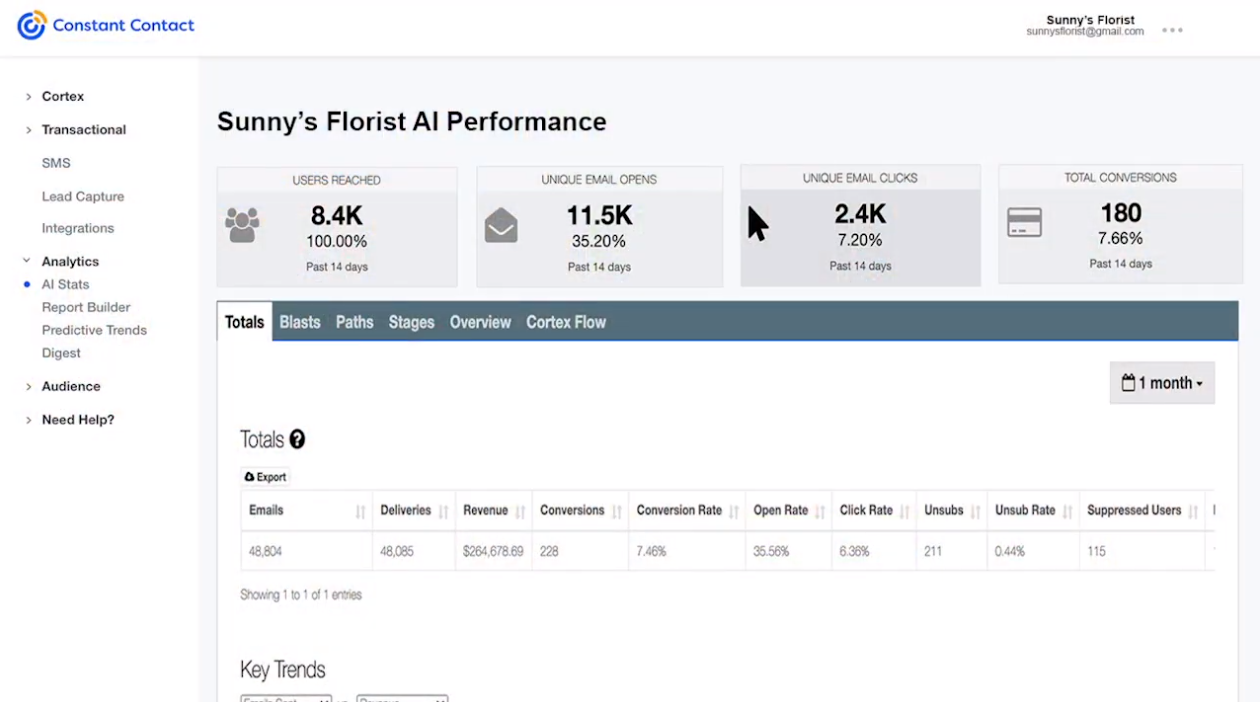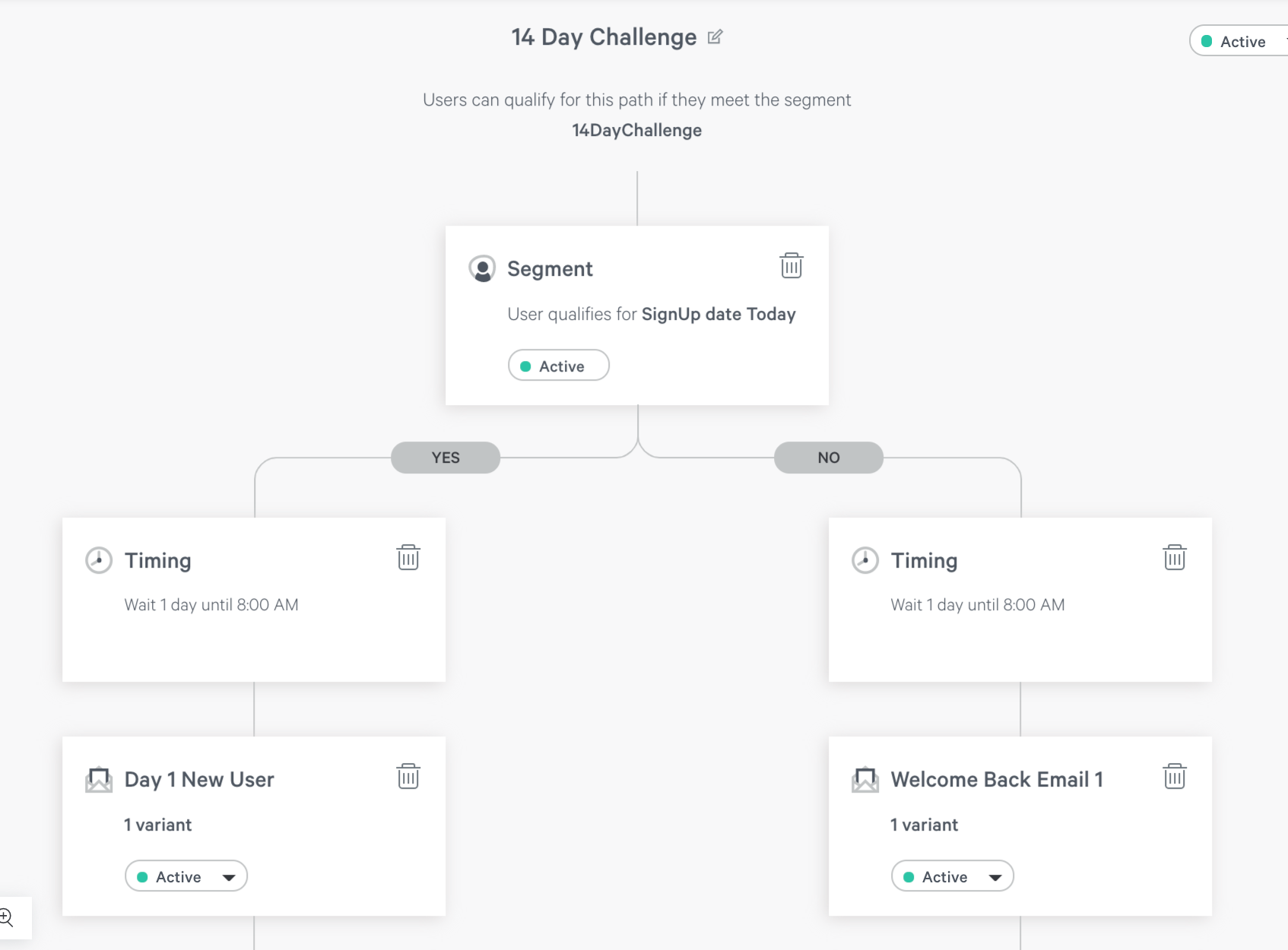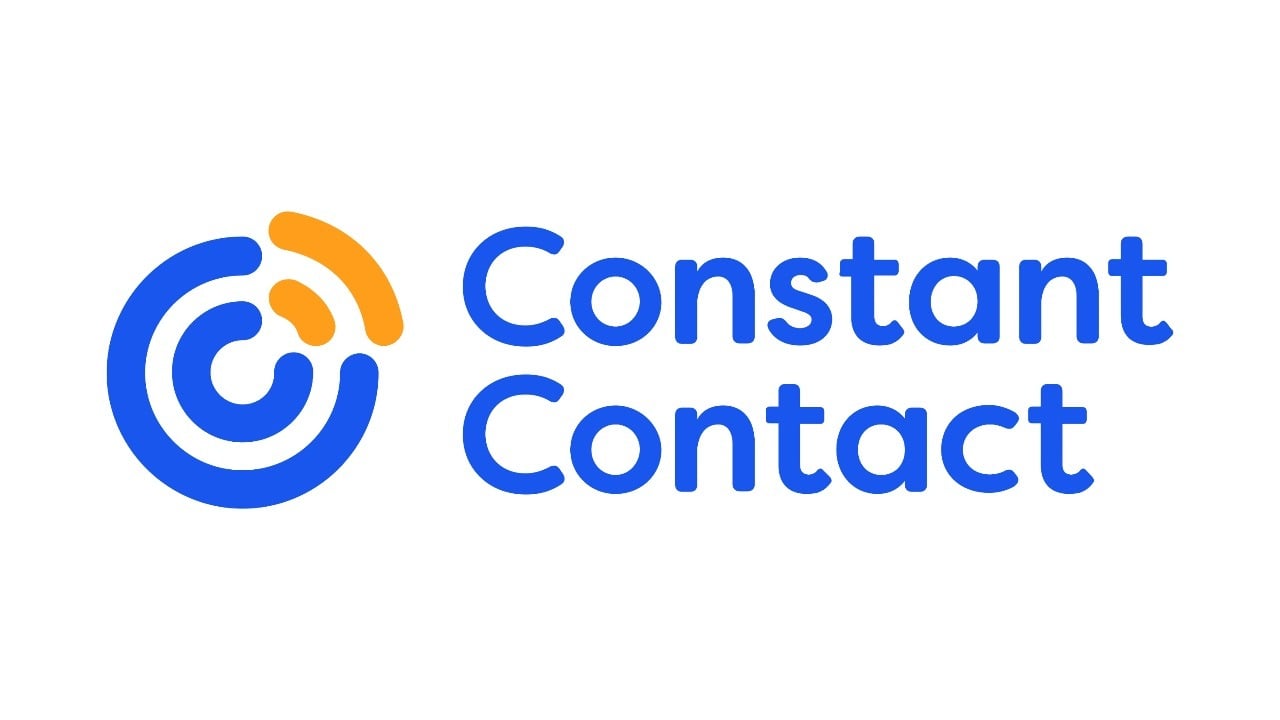-
Pros
- Intuitive and elegant UI
- Wide range of third-party integrations
- Superior email deliverability rate
-
Cons
- Templates don't offer much flexibility
- Relatively expensive if you have thousands of contacts
- Lacks multi-channel automation
Constant Contact Specs
| A/B Testing | |
| Annual Plans | |
| CRM Integration | |
| Drag-and-Drop Creation | |
| Image Library | |
| Limited Free Trial | |
| Marketing Automation | |
| REST API | |
| Search Marketing | |
| Social Media Integration | |
| Survey Tool | |
| Unlimited Email | |
| Unlimited Sequencing |
Constant Contact is an email marketing solution that supports general brand marketing and e-commerce-focused marketing. You'll find a good mix of starter features, third-party integrations, and a generous 60-day free trial to get a feel for the service. Constant Contact is easy to use and integrate with other online services, but its feature set is notably aimed at small businesses. This positions it somewhat behind our more robust and flexible Editors' Choice winners, Brevo, Campaigner, and Mailchimp.
Constant Contact Pricing
Constant Contact offers three plans, which vary in price based on the package and the number of contacts and emails sent. The service uses tiered pricing, which means you pay more depending on how many emails you send. For example, 0 to 500 emails cost $12 per month with the Lite plan, while 45,001 to 50,000 emails cost $430 per month with the same plan.
The most inexpensive option is the Lite plan, starting at $12 a month. This limits you to a single-user account, and your monthly email limit is 10x your total number of contacts. The Lite plan gives you drag-and-drop email templates, marketing CRM, event management, and basic social media marketing features.
The next step up is the Standard plan, which starts at $35 per month for up to three users. Your monthly email limit is bumped to 12x your total number of contacts. In addition to all of Lite's features, Standard gives you more automation functions, such as list-building tools, scheduled email sends, and subject line A/B testing. Those features should tick all the boxes that most small to midsize businesses (SMBs) need, though with an emphasis on smaller organizations.
Next is the Premium plan, which starts at $80 a month for unlimited users. It has all the Standard plan features, but adds customizable automation and segmentation, Google Ads manager, 500 SMS messages, revenue reporting, and SEO recommendations (a nice feature if you're just getting your feet wet in digital marketing). With the Premium tier, your monthly email limit jumps to 24x your total number of contacts.
Constant Contact's email-oriented pricing makes it particularly appealing for smaller businesses with limited contact lists. On the other hand, Brevo is a great alternative service that also edges out Constant Contact on pricing. Brevo's Starter plan ($25 per month) begins with 20,000 emails and offers basic analytic tools. Its more robust Business plan ($65 per month) gives you marketing automation, A/B testing, send time optimization, and advanced statistics. Larger businesses with mass-marketing needs should look to Campaigner for highly customizable email marketing solutions, starting at $59.
That said, what makes Constant Contact competitive is its 60-day free trial. That's well beyond what the competition offers, and it includes most of the service's features (plus an easy path to upgrading to a paid tier). The free trial doesn't automatically roll over to a paid plan, and you can still access your data without signing up. There is also a 60-day money-back guarantee, which is also generous compared with most of the other services we've reviewed.

Creating a Subscriber List With Constant Contact
There are several ways to get your subscriber lists into Constant Contact. You can copy and paste, manually type addresses into a form, upload a file (CSV, TXT, XLS, or XLSX), directly import them from a Gmail or Microsoft Outlook address book, or import them from several compatible customer relationship management (CRM) tools, including HubSpot CRM, Nutshell, and Pipedrive.
We uploaded four Microsoft Excel and CSV documents with overlapping contacts and the uploads were fast and mostly accurate. Constant Contact recognized most of our data fields and merged duplicate contacts. We had to map a few fields and add a new custom field, which was easy and on par with most of our small business-focused competitors, like Campaign Monitor.
Our only quibble here is that it's a pain to edit user records. If you want to add more detail to several contacts, you must individually load each record and update the fields. We would prefer doing a quick edit from the main contact list, as you can with Brevo, since it would make the process much less tedious. Of course, the best way to avoid this is to have a spreadsheet with complete information in the first place, but that's rarely the case.
Another way you can grow your subscriber list is by creating web forms that let your customers sign up for newsletters and other promotional emails. Constant Contact offers landing pages, and integrates with OptinMonster, Facebook Lead Ads, and the Facebook Join My List app. You can segment new contacts based on which of these methods they used for opting in, which is also useful when segmenting your lists.
Like its competitors, Constant Contact requires you to verify that you already have consent from your entire list—no bought lists allowed! You also cannot use group addresses such as sales@ or marketing@ addresses or distribution lists since there is no way to verify you have consent from every person receiving messages sent to such addresses.
Since we last tested it, Constant Contact has improved its ability to monitor fraudulent activity. You want this because it keeps your emails from dropping into your customers' spam folders. It also contributes to Constant Contact's claim of a 90 percent email delivery rate. The company's updated, AI-powered spam-detection algorithm uses machine learning to scan and prevent fraudulent or malicious content in emails.

Campaign Creation in Constant Contact
Creating a campaign is as easy as selecting either Email, Email Automation, Event, or Survey. If you want to revisit a campaign or copy it, you can search for campaigns by date or keywords or view the Recents tab. Constant Contact also has an integrated marketing calendar so you can schedule emails based on holidays or other events.
For an email campaign, you can use a template to get started. Constant Contact redesigned its drag-and-drop editor since the last time we tested it, so it now has many layout options and fewer restrictions. The editing tool lets you tweak text with access to Google fonts as well as images and colors. You can add a blog post teaser and import PDFs that transform into interactive emails. Constant Contact also has a branded template builder that can grab your company's logo, color scheme, and social media links, and incorporate it all into your emails.
New to Constant Contact are its AI-powered tools. Should you have trouble crafting marketing content like an email subject line, product description, social media post, or even email content, you can let AI take the wheel and offer suggestions. This tech has become quite commonplace, with services such as Brevo and Hubspot Marketing Hub adding AI generation to their toolbelts.
Constant Contact's mobile options are a little weak. It has mobile-aware templates, but not all templates have this feature. The preview capability for mobile-oriented emails also isn't as flexible as it is in other packages, especially top-tier players like Mailchimp. On the other hand, if you really can't find anything that works for you in Constant Contact's bundled library, the company offers a custom email template design service that'll craft anything you need, though this is an added cost option.
You'll have a media library available for storing your company's assets, such as logos and other images. The image library now has 2GB of space but with a maximum file size of 5MB. Also similar to Campaign Monitor, you'll have one-click access to free and paid stock photos.
Once a newsletter is ready to go, you can send it right away or schedule it for later (in five-minute intervals, such as 3:05 a.m., 3:10 a.m., and so on). You can also send recurring emails for birthdays and anniversaries, though there's no option to send messages on a daily, weekly, or monthly basis like Campaigner offers (or to send messages based on the local time at the recipient's location, as GetResponse does).
Improved Integrations
One of Constant Contact's draws is that it has a wide variety of integration options for a product aimed at smaller businesses. This includes e-commerce partnerships with Etsy, eBay, Shopify, and Vimeo, as well as Eventbrite. The Eventbrite integration lets subscribers RSVP, respond to polls, download coupons, and make donations right from the email rather than having to go to a landing page. The same goes for product descriptions and buy buttons. There's also the ability to create Abandoned Shopping Cart emails that you can use to follow up with potential customers, a feature that's important for direct-to-consumer (DTC) retailers and e-sellers.
Constant Contact has an array of other integrations focused on things like SEO and social media marketing. There's in-app Facebook and Instagram ad creation and a decent selection of social media monitoring tools, though not as full-featured as tools dedicated to that purpose. There's also access to Google My Business and an SEO tool for optimizing things like keyword usage. Again, for a tool aimed at smaller companies, that's a lot of power under the hood.

Campaign Tracking in Constant Contact
Once you've sent your email, you can track its success by using the redesigned Reporting tab. The dashboard displays the basics, including opens, click-throughs, bounces, and unsubscribe requests. You can also see your most engaged subject line as well as opens on desktop versus mobile.
Constant Contact has video tutorials that walk you through what all your reports mean, and a wealth of information about things like crafting effective subject lines and other ways to improve your open rate. The mobile application is handy if you need to see how your campaign is performing while you're on the go.
The Report page is also where you can see the results of subject line A/B tests, which comes up as a heat map that shows where subscribers are interacting. However, just as with Campaign Monitor, you can't build custom reports. The canned reports, while useful, are all you'll get unless you export your data to another reporting tool.

Email Automation in Constant Contact
To create an automated series (previously called an "autoresponder"), select Email Automation from the Campaign options view. Start by selecting an email trigger. These are subscriber actions, like opening the email, clicking any link, clicking a specific link, or having a new contact join a list. Then, you can create a new email or use one from an existing campaign, and this will be sent automatically in response to the action. You've got flexibility when it comes to how long you want to wait until the follow-up email is sent and you can add as many of these automatic emails as you'd like to a particular campaign.
Where Constant Contact comes up a little short in automation is that it's focused solely on email marketing. Other players, like HubSpot Marketing Hub and Mailchimp, have multi-channel automation features that can create workflows emails, social media, and SMS activity.
Constant Contact Customer Support
Constant Contact is easy to use and has plenty of help options, beginning with the Information icons that are located next to the Options tab in most dashboard views. You can also access an extensive collection of Knowledge Base (KB) articles and there are even coaches available at a toll-free number.
A small downside is that phone support isn't available 24/7, but the hours are still generous. It's available from 8 a.m. to 8 p.m. ET Monday through Friday and 10 a.m. to 6 p.m. ET on Saturdays. Note that these hours have been reduced since we last reviewed the service. If the phone doesn't suit you, you can use live chat, and you can also interact with customer support via Twitter.
An Ideal Marketing Solution for SMBs
Constant Contact is an accessible email marketing service that is well suited for small and even midsize businesses. Its e-commerce options are particularly appealing to companies expanding into the online marketplace. The wide selection of templates should satisfy beginners, though more advanced creative designers may find them lacking a bit when it comes to customization. Constant Contact is a respectable contender in the field, but our Editors' Choice winners Brevo, Campaigner, and Mailchimp offer more flexible and well-rounded packages by comparison.
Gadjo Sevilla contributed to this review.

